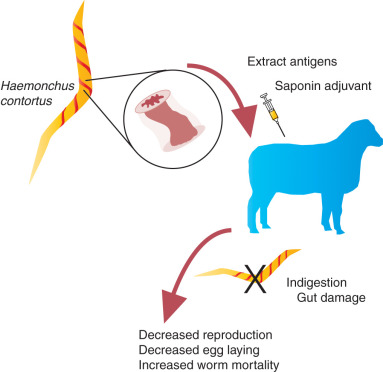HAEMONCHOS CONTORTUS/HAEMONCHOS-CONTORTUS

Haemonchus contortus, known as the barber pole worm, is relatively common in the abomasum of ruminants. The common name of this parasite is related to the macroscopically visible intertwining of the blood-filled intestine and white uterus in the female worm (Fig. 7-164). Hyperinfested grasses containing numerous third instar larvae are the source of infection.
Lambs are particularly at risk. Grass larvae are ingested by the host and enter the abomasum, where they may lie dormant within the gastric glands. After development to adults, they emerge on the abomasal surface and attach through a buccal tooth. The eggs pass in the feces, completing the life cycle.
Haemonchus feed on blood and can cause severe anemia, hypoproteinemia, and the resulting edema. This edema is characteristically present in the intermandibular space, resulting in a physical resemblance to a bottle ("bottle jaw"). As with any process that results in anemia and hypoproteinemia, there is pale mucous membranes, atrophy, and diarrhea. Diagnosis is based on fecal egg count and necropsy by semi-quantification of the parasite load in the abomasum together with the concomitant lesions of anemia and hypoproteinemia.
At necropsy, the carcass is pale and shows generalized edema and fluid in all body cavities secondary to hypoproteinemia. The contents of the abomasum are fluid and discolored by free blood. Mucosal hemorrhage foci are present at the sites of worm attachment.
There are no products listed under this category.
